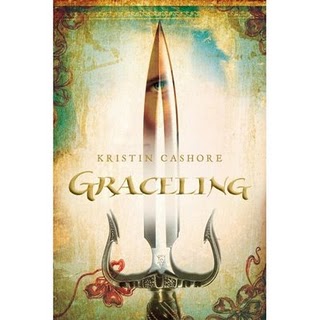Q: When you see a YA book cover with an Asian face on it do you:
a. Think "oh good a story about Asian characters!" and pick it up.
b. Think "oh, no a story about Asian characters!" and not pick it up.
c. Think "oh, no, more ghettoization of Asian authors and stories" and still pick it up
d. Think "wish that was a more modern Asian riot grrrl on the cover rather than that exotified, Orientalist image"and then glue a picture of your own fabulous self on the book cover (*NB - please do not deface books, even ones you own! This is only a joke!*)
So in honor of Lunar New Year, I thought I'd bring up an issue relevant to the broader Asian writing community. There's been a lot of talk lately online about YA bookcovers. Particularly, the representation (or lack thereof) of Asian faces/bodies on the covers of stories about Asian main characters.
To see the origins of a recent conversation, see this fabulous blog post by
Malinda Lo on Enchanted Inkpot, which is a hilarious categorization of several general YA cover trends - from the close up to magical beasts to lady killers (that is, ladies who ARE killers, my favorite trend by far). In the comments section, there arose a heated conversation about the representation of Asian (appearing) faces on books ostensibly about Asian main characters.
The conversation continued at Malinda's site, in a post she wrote called
"Don't Judge A Book by it's Cover." In the comments, some authors articulated their own discomfort with those who would point fingers at their publishers, or the publishing industry in general, for perhaps 'downplaying' the 'Asian-ness' of certain book covers. The argument put forth, a valid one, was that what we want to do is support the sale of multicultural authors' books, as well as stories with multicultural protagonists. That book covers, even when they might belie the story within, are just that. Covers. Not to be judged by, and all that.
But of course these discussions occur in a backdrop of other explicit critiques of
'whitewashing' in YA covers where authors and activists have urged the marketplace to accurately represent the diversity that is American young people today. The case oft brought up is that of
Justine Larbalestier's Liar, whose cover was changed from the face of a white (appearing) young woman to that of a young woman of color, primarily due to the author herself's protests.
I've been thinking a lot about this conversation lately. When it happened, it was (by happenstance) January 26th, India's Republic Day. As a granddaughter of one of the oldest Indian freedom fighters still alive, the daughter of a lifelong South Asian feminist activist in this country, identity and community action has always been a critical part of my life and work - from the clinical to the academic to the artistic to the personal. I felt the issue of representation - the presence of Asians in the literary marketplace - quite keenly. But I also heard what these authors were saying. In critiquing covers, were the commenters attacking the authors and/or publishers who bought and supported their work? I certainly hope not, if our goal is to support and celebrate diverse voices in YA literature.
The issue of Asian book covers seems to be in the air. Just today,
Mitali Perkins posted some changes in her own novel
The Secret Keeper between its US and Indian editions. And while they are both actually very beautiful, they are both obviously very different. In the very broadest strokes, the US version declares, to me, that 'this is a book with Indian/Asian themes.' The colors, the design, the face, all point in this direction. The Indian version, conversely, is more whimsical and perhaps even youthful - almost suggesting to me 'this is a book about YA themes.' Why the difference? Obviously something to do with the differing marketplaces, but beyond that, it's not clear.
Then of course there are these insightful posts from
Sociological Images and
Hyphen Magazine on manufacturing Asian-ness on book covers - the suggestion here was that certain stereotypical, exotified images, like fans, dragons, and somber female faces are common themes on at least adult books marketed in the U.S. with 'Asian themes.'
Which of course begs the questions - what constitutes an 'Asian' theme anyway? And who defines 'Asian-ness'? (and does this notion differ between the US/UK/Canada and, well, Asia itself?)
And of course the related, more dangerous issue - which is, if Asian and Asian American authors are somehow required to only write stories with certain kinds of (serious, somber, exotic, Orientalist) Asian themes?
These are complex questions without facile answers. In the end, the struggle is to get MORE Asian inspired stories, Asian and Asian American authors, and yes, Asian faces out there. But how and why and to what ends is of course of primary import. More exotified 'geisha girl' images? No thanks. More images of 'real-life' (or fantasy life) Asian young women (and men? what a revolutionary thought!), great.
There is of course, much wonderful work already underway. The good folks at the
Asian American Writer's Workshop have been supporting Asian American writers for years. In the YA community, Malinda Lo and Cindy Pon have recently organized a
Diversity in YA tour.
Mitali Perkins and
Cynthia Leitich Smith remain fabulous sources of information for YA writers of all hues. Only recently, the visionary
Olugbemisola Rhuday-Perkovich has begun
The Patchwork Collective, a virtual mentoring group for kid/YAlit writers of color.
In the end, I think the call is for more stories, more voices, more words, more diversity. More tales that speak to Asian (and of course other usually silenced- Latina, African American, Queer - experiences). More protagonists who look like our sons and daughters.
Yes, on all those scores. Yes, yes, yes, please.








